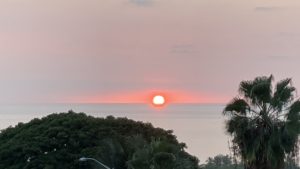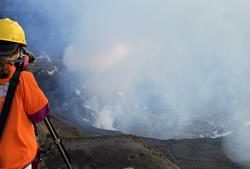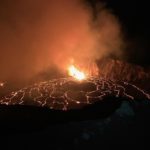The Hawaiian Volcano Observatory Friday morning, Dec. 25, 2020 update on Kilauea Volcano, as of 7:56 a.m.:
19°25’16” N 155°17’13” W, Summit Elevation 4091 ft (1247 m)
Current Volcano Alert Level: WATCH
Current Aviation Color Code: ORANGE
Activity Summary: No significant change. Lava activity is confined to Halemaʻumaʻu from two vents on the north and northwest sides of the crater. As of 7 this morning, the growing crater lake was 176 m (577 ft) deep. High SO2 emissions continued.
Summit Observations: Summit tiltmeters continued to record steady deflationary tilt. Sulfur dioxide emission rates remain high estimated at around 35,000-40,000 tonnes/day as measured on Monday (Dec. 21) and revised Wednesday (Dec. 23). Seismicity remained elevated but stable, with a few minor earthquakes and tremor fluctuations related to the vigor of fissure fountaining.
Photo below is of sunset in the voggy sky from Kailua-Kona on Thurs., Dec. 24, 2020, courtesy Sherry Bracken:

Halemaʻumaʻu lava lake observations: Two vents continued erupting on the north and northwest walls of Halemaʻumaʻu. The west vent, which is located on the lowest down-dropped block within Halemaʻumaʻu crater, was intermittently spattering. The north vent remains the most vigorous and is being slowly drowned by the rising lake..
The vents continued to feed lava into a rapidly enlarging lava lake filling Halemaʻumaʻu crater. As of early this morning, the lake was 176 m (577 ft) deep–an increase of 6 m (20 ft) over the previous 24 hrs. The lava lake volume this morning (Dec. 25) was about 21 million cubic meters (27 million cubic yards or 4.8 billion gallons).
An island of cooler, solidified lava within the lava lake has been getting smaller and drifting slowly northeastward in the lake. It is about 260 m (850 ft) in length and 115 m (375 ft) in width based on the Dec. 23rd thermal map (https://www.usgs.gov/maps/december-23-2020-k-lauea-summit-eruption-thermal-map).
Webcam views of the lava lake can be found here: https://volcanoes.usgs.gov/volcanoes/kilauea/multimedia_webcams.html.
Hazard Analysis: High levels of volcanic gas, rockfalls, explosions, and volcanic glass particles are the primary hazards of concern regarding this new activity at Kīlauea’s summit. Large amounts of volcanic gas—primarily water vapor (H2O), carbon dioxide (CO2), and sulfur dioxide (SO2)—are continuously released during eruptions of Kīlauea Volcano. As SO2 is released from the summit during this new eruption, it will react in the atmosphere with oxygen, sunlight, moisture, and other gases and particles, and within hours to days, convert to fine particles. The particles scatter sunlight and cause the visible haze that has been observed downwind of Kīlauea, known as vog (volcanic smog), during previous summit eruptions. Vog creates the potential for airborne health hazards to residents and visitors, damages agricultural crops and other plants, and affects livestock operations. Rockfalls and minor explosions, such as the ones that occurred during the 2008–2018 lava lake eruption at Kīlauea summit, may occur suddenly and without warning. This underscores the extremely hazardous nature of Kīlauea caldera rim surrounding Halemaʻumaʻu crater, an area that has been closed to the public since late 2007. Pele’s hair and other lightweight volcanic glass fragments from the lava fountains within Halemaʻumaʻu will fall downwind of the fissure vents and lava lake, dusting the ground within a few hundred meters (yards) of the vent. High winds may waft lighter particles to greater distances. Residents are urged to minimize exposure to these volcanic particles, which can cause skin and eye irritation similar to volcanic ash.
Vog information can be found at https://vog.ivhhn.org/.
Please see this Hawaii Volcanoes National Park Press Release “How to Safely View the New Eruption in Hawaiʻi Volcanoes National Park” at https://www.nps.gov/havo/learn/news/20201221_nr_new-summit-eruption-kilauea.htm.
Note: HVNP is open 24 hours a day. Park spokeswoman Jessica Ferracane says it is quite crowded now between 6 p.m. and 10 p.m., and advises visitors to try to see the eruption outside of those hours.
The Hawaiian Volcano Observatory (HVO) continues to closely monitor Kīlauea’s seismicity, deformation, and gas emissions for any sign of reactivation, and maintains visual surveillance of the summit and the East Rift Zone. HVO will continue to issue daily updates and additional messages as needed.
MORE INFORMATION:
Kilauea Activity summary also available by phone: (808) 967-8862
Other Hawaiian volcanoes summary also available by phone: (808) 967-8877
Subscribe to these messages: https://volcanoes.usgs.gov/vns2/
Kilauea Webcam images: https://www.usgs.gov/volcanoes/kilauea/webcams
Kilauea Photos/video: https://www.usgs.gov/volcanoes/kilauea/photo-video-chronology
Kilauea Lava flow maps: https://www.usgs.gov/volcanoes/kilauea/maps
Haleakala Summary: https://www.usgs.gov/volcanoes/haleakala
Hualalai Summary: https://www.usgs.gov/volcanoes/hualalai
Loihi Summary: https://www.usgs.gov/volcanoes/loihi-seamount
Mauna Kea Summary: https://www.usgs.gov/volcanoes/mauna-kea
Definitions of terms used in update: https://volcanoes.usgs.gov/volcanoes/kilauea/extra/definitions.pdf
Summary of volcanic hazards from Kīlauea eruptions: https://volcanoes.usgs.gov/volcanoes/kilauea/extra/hazards.pdf
Recent earthquakes in Hawaiʻi (map and list): https://www.usgs.gov/observatories/hawaiian-volcano-observatory/earthquakes
Explanation of Volcano Alert Levels and Aviation Color Codes: https://www.usgs.gov/natural-hazards/volcano-hazards/about-alert-levels
Attached photo: An early December 25, 2020, morning view of the ongoing eruption in Halema‘uma‘u crater at Kīlauea’s summit. Overnight fountaining continued to feed the rising lava lake, which slowly fills Halema‘uma‘u. This photo, taken at approximately 2:30 a.m. from the south rim of the crater, shows the main northern vent that is being drowned by the rising lava lake. Intermittent activity continues at the weaker west vent. USGS photo by J. Schmith and C. Parcheta.
Below photo: HVO field crews measured Kīlauea’s summit lava lake this morning (Dec. 25) around 7:30 a.m. HST. The lake surface is now 445 m (1460 ft) below the crater rim observation site, indicating that the lake has filled 176 m (577 ft) of the bottom of Halema‘uma‘u crater. The lake rose approximately 6 m (20 ft) over the past 24 hours. Fountaining continues at two locations, more vigorously at the northern (eastern) vent that is being drowned by the rising lake, and intermittently at the western vent; both vents continue to feed the growing lava lake. The lava lake volume this morning (Dec. 25) was about 21 million cubic meters (27 million cubic yards or 4.8 billion gallons). High SO2 emissions continue. USGS photo.

